The conditional tense is usually introduced with the future tense because the two tenses have much in common. For example, the same verbs that are irregular in the future tense are also irregular in the conditional tense in exactly the same way. The conditional tense also requires you to use the entire infinitive, only with different endings. Because the future and conditional tenses are created in a similar fashion, it is very easy to learn to conjugate verbs in the conditional tense once you have learned the future tense; the meanings of the two tenses, however, are not similar at all.
The conditional is used when the action of the verb would happen only if a certain condition were met. In an English sentence in the conditional tense, the helping verb “would” is placed in front of the main verb, which is usually followed by the words “if” or “but.” In the sentences, “I would study if I had my book” or “He would study but he doesn't have his book,” the condition that needs to be met in order for studying to happen is “having a book.” In the following example, you must infer the condition that must be met before Benjamin can visit his grandma.
- Benjamín visitaría a su abuela pero ella vive en Europa.
- Benjamin would visit his grandmother but she lives in Europe.
The above sentence implies that the condition that must be met before Benjamin visits his grandma is that she would have to move closer to him.
In Spanish, when the conditional tense is followed by si (“if”), the next verb is in a tense called the imperfect (past) subjunctive. In the following examples, tuviera is the past subjunctive form of the verb tener.
- Yo hablaría español si yo tuviera mi diccionario.
- I would speak Spanish if I had my dictionary.
- Britanía viajaría a África si tuviera el dinero.
- Britanía would travel to Africa if she had the money.
The English language has a bad habit of using the same word to mean completely different things. Unfortunately, when an English sentence places the helping verb “would” in front of the verb, it does not always mean that you will use the conditional tense in a Spanish translation. Sometimes, the English language uses the helping verb “would” to indicate a repetitive action in the past. For example, the sentence “I would study every night when I was in high school” would not be translated using the conditional tense because it is not actually saying “I would study if …” or “I would study but …” This sentence does not imply that a condition must be met in order for the action of the verb to happen. Technically, in the above sentence, “would study” means “used to study.” Thus, in Spanish, the verb would be conjugated in the imperfect tense to indicate an ongoing or repetitive action in the past.
Although the above explanation may sound confusing, there is an easy way to determine whether you need to use the conditional or the imperfect tense. If an English sentence has the word “would” in front of the verb, try changing “would” to “used to.” If it still sounds right, use the imperfect. If not, use the conditional tense.
Read the following sentences and consider in which sentence you can change the underlined “would” to “used to.”
- Cuando niña, Tatiana hablaba con su tía todas las noches.
- As a child, Tatiana would speak with her aunt every night.
- Tatiana hablaría con su tía si ella tuviera teléfono.
- Tatiana would speak to her aunt if she had a phone.
It doesn't sound quite right to say “Tatiana used to speak to her aunt if she had a phone.” Therefore, the second sentence should be translated in the conditional tense. It sounds perfectly correct to say, however, “As a child, Tatiana used to speak with her aunt every night”; thus, you know that the imperfect is the appropriate tense to use in the Spanish translation.
Regular verbs
To create the conditional tense of regular verbs, the conditional ending for each form is added to the entire infinitive. Because the entire infinitive is used, there is no need for three different conjugation charts for the three different kinds of infinitives (‐ar, ‐er, and ‐ir verbs). The endings in Table are added to the entire infinitive of any regular verb to create the conditional tense. The 12 verbs that are irregular in the future tense are also irregular in the conditional tense.
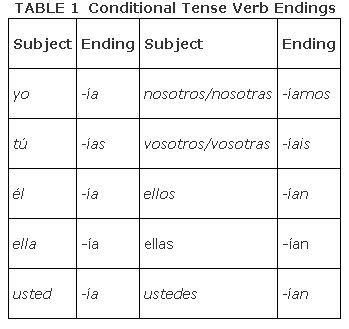
Notice in the examples of regular verbs conjugated in the conditional tense (see tables , , and ) that the entire infinitive is simply placed in front of the conditional tense endings from Table .

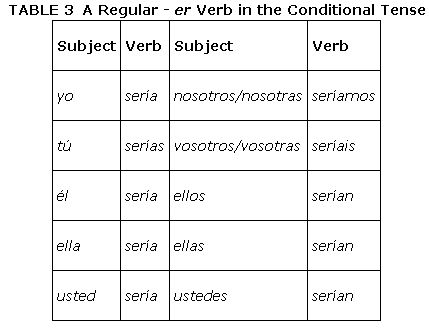
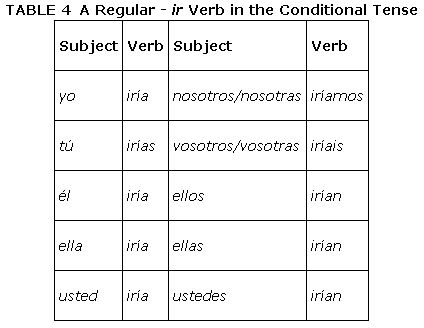
Irregular verbs
As you now know, the good news about the conditional tense is that, like the future tense, it has only 12 verbs that are irregular—and these are the same verbs that are irregular in the future tense. The irregulars listed below follow exactly the same patterns as well.
Five irregular verbs simply drop the e of the infinitive (see tables and ):

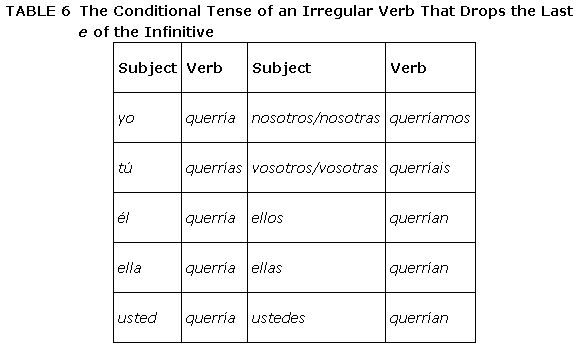
Five other irregulars change the last vowel of the infinitive to the letter d (see Tables and ):

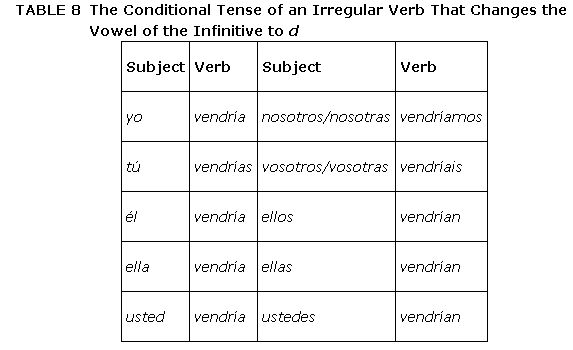
The conjugation chart of the verb venir in Table is an example of this type of verb in the conditional tense.
The final two verbs, hacer and decir are irregular in the conditional tense because they drop the letters e and c from the infinitive. Notice that the e and c are not in the same order for both verbs (see Table ).
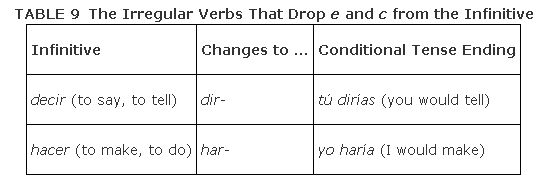
|
|
|
|
|
|
|
|
|
|
|
|
|
|
|
|
|
|
|
|
|
|
|
|
|
|
|
|
|
|
|
|
|
|
|